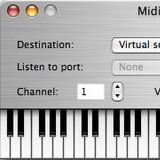Chris Reed has released version 1.8 of MidiKeys, a free virtual MIDI keyboard for Mac.
MidiKeys is a small application for Mac OS X that presents a miniature MIDI keyboard onscreen. You can use the computer keyboard to play MIDI notes, or click on the keys with the mouse. There is also an option to select a MIDI source and see incoming notes played on the keyboard.
MidiKeys has no way to produce sound on its own. In order to hear a sound when you press keys, you need to connect the MidiKeys output to a synthesizer of some sort. This can be either a softsynth or a hardware synth connected through a MIDI I/O box. Apple’s AU Lab works nicely to play Audio Units.
Changes in MidiKeys v1.8
- MidiKeys is now a universal binary.
- Minimum system is now 10.5.
- Changed ownership to Immo Software.
- New configurable hot key to toggle global hot keys.
- Support for automatic software updates using the Sparkle framework.
- New option to show the key caps on the on-screen keyboard.
- The MIDI channel field has been changed to a pop-up menu.
- The disclosure button to show the destination and listen menus is now a normal button instead of being a repurposed toolbar toggle button.
- Pressed key highlights are drawn with a slight gradient.
- New Global Hot Keys menu item.
- New preferences to control the visibility of overlay notifications.
- It is now possible to have no modifier key for global hot keys, so you only have to press the key corresponding to the note.
- Key maps were extended to use more keys on the keyboard.
- Non-English localisations have been disabled for this release due to the number of UI changes.
- Added a preference to make the keyboard window transparent to mouse clicks when MidiKeys is in the background.
- Made the keyboard window minimizable.
- Reorganized the preferences window with several tabs.
- Added preferences to control software updates.
MidiKeys is available to download as a freeware application for Mac.
More information: MidiKeys




